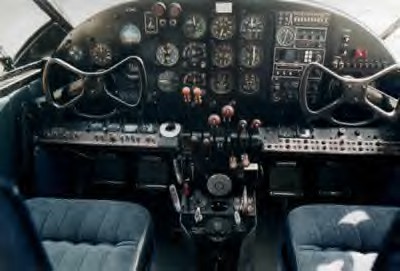When
production began on the Model 18 in 1937, there was
virtually no market for this airplane in the United
States. At the time, air transportation in the
United States was a trunk line operation, and few
feeder lines existed. Acceptance of the Model 18 by
foreign and charter lines was immediate, however.
The Model 18A, which also operated on
interchangeable ski- or float-landing gear, was an
ideal adaptation for snowbound areas and for lake
and inter-island service. Prairie Airlines of
Alberta, Canada, for example, ordered several of
these airplanes for use in delivering air mail over
a route that extended from Prince Albert to North
Battleford, south to Saskatoon and Moose Jaw,
finally joining up with the main route of Trans
Canada Airlines at Regina. Also, businessmen were
favourably impressed with the performance of the
Model 18 as an executive transport, with orders
coming from Alaska, Canada, and Puerto Rico.

On
January 13, 1939, Beech began negotiations with the
U.S. government on a contract for a photo
reconnaissance version of the 18. Fourteen of these
aircraft, designated Type F-2, were ordered as part
of the Emergency Procurement Program. This order was
followed by a contract for eleven C-45 personnel
transports. Later that year, Beech began
negotiations with the Chinese government for a
bomber trainer. This version had a clear plastic
nose, a single gun turret on the upper fuselage, and
a machine gun in a tunnel in the rear floor. It also
had internal bomb racks, which carried up to twenty
25-pound bombs.
1939
also saw a standard Beech 18S set a new flight
record while on a demonstration tour, flying from
Bogota to Barranquilla, Colombia, a distance of 450
miles, in 1 hour, 54 minutes. Later the same
airplane made a 1,350-mile flight from Maracay,
Venezuela, to Miami, Florida, in 6 hours, the first
known non-stop flight between those two cities. To
further demonstrate the capable performance of the
Beech Model 18, Walter Beech entered a D18S in the
1940 Macfadden Race from St. Louis to Miami. With
"Ding" Rankin as his pilot, Beech crossed the finish
line in Miami in 4 hours, 37 minutes to win first
place. Their average speed for the flight was 234
mph.
World War II brought more orders for military
versions of the Beech 18S from the United States and
foreign governments for a wide range of uses. About
90 percent of the U.S. Air Force's navigators and
bombardiers received their training on AT-7s and
AT-11s respectively. The U.S. Navy SNB-1 was similar
to the AT-11, the SNB-2 to the AT-7. The JRB-1 was a
radio-control airplane for target or drone aircraft.
The Navy's personnel transports similar to the C-45
were known as JRB2, JRB-3, and JRB-4.


With
the end of the war came the end of military
production, although many of these aircraft remained
in service for years. By October 1945 Beech was back
into full commercial aircraft production. The first
aircraft off the line was the newest model, the
D18S, which incorporated a number of improvements.
Structural modifications allowed for an increase in
maximum weight and new landing gear, brakes, and
tires were installed. Two 450-hp Pratt & Whitney
Wasp, Jr., engines with Hamilton Standard constant
speed propellers powered the D18S. It was the
premier executive transport among businessmen and it
was also used by the new local service airlines that
emerged after the end of World War II.
On
December 10, 1953, the prototype of the Super 18,
the last version of the Beech 18, made its first
flight. The last three production aircraft were
delivered in November 1969. More than 9,000 Model
18s were produced since 1937, and, in 1970, more
than 2,000 were still being flown in the United
States alone.
- TYPE: Light
utility transport.
- PERIOD BUILT:
1937-1969
- COUNTRY OF
ORIGIN: United States
- ENGINES: Two
Pratt & Whitney R-985AN-14B Wasp Junior 9-cyl.
radial piston engines of 450 hp.
- DIMENSIONS:
